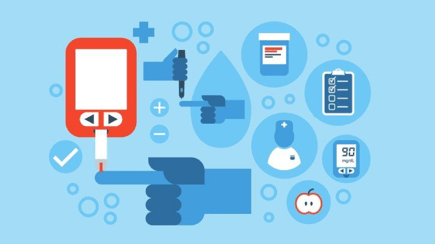 According to the Centers for Disease Control and Prevention (CDC), an estimated 30.3 million people of all ages—or 9.4% of the U.S. population—had diabetes in 2015. Despite the prevalence of diabetes, there are still a lot of misconceptions when it comes to meal planning for someone with diabetes.
According to the Centers for Disease Control and Prevention (CDC), an estimated 30.3 million people of all ages—or 9.4% of the U.S. population—had diabetes in 2015. Despite the prevalence of diabetes, there are still a lot of misconceptions when it comes to meal planning for someone with diabetes.
- Do I avoid foods high in sugar?
- Do I follow a “no carb” diet?
- Do I just avoid foods that are white?
Our Registered Dietitians want you to know that almost all foods can be incorporated into a diabetic diet, it just requires planning and preparation to know how to do it well! We recommend getting started by trying to incorporate the following steps.
- Get on schedule
Try to stick to a consistent meal schedule, like eating a small meal or snack every 4 hours or so while you are awake. Consistency with meal times can prevent overeating, which many people might do if they skip a meal. - Variety is key
You don’t need to completely avoid certain food groups in order to maintain good blood glucose control. An easy way to get a variety of nutrients at meals is by following a plate method that incorporates ½ plate non-starchy vegetables (broccoli, carrots, tomatoes, mushrooms, etc.), ¼ plate protein (chicken, fish, eggs, etc.), and ¼ plate starches/grains (brown rice, sweet potatoes, black beans, etc.), while adding a serving of fruit (apples, peaches, pears, etc.) and/or dairy (milk/yogurt) to that meal. - Choose carbohydrates that are going to give you the “biggest bang for your buck”
We want to be mindful of which foods are high in carbohydrates, as it is the carbohydrates in foods that raise blood sugars. However, not all carbohydrates are created equal. High carb food groups include fruit, dairy, and grains. Choose foods from these food groups that are also high in fiber and/or protein as these foods will keep you fuller longer. Examples include whole fresh fruit, low-fat milk and yogurt, and whole-grains/high fiber starches (like beans, brown rice, and whole wheat bread).| - Control you portions
Always read food labels and measure portion sizes. This way you know exactly how many carbohydrates you will be consuming from that particular food. Really want some ice cream with dinner one night? It might be okay for you to have ½ cup serving, but eating a whole pint would probably not fit into your carb counting plan. By measuring out a portion you know exactly what you’re getting and whether or not that will fit in your meal plan. In general, we recommend around 30-45 grams of carbohydrate per meal for a woman with diabetes and 45-60 grams of carbohydrate per meal for a man with diabetes, however these numbers can differ. - Be active
Physical activity is a great way to manage blood glucose. Aim for at least 150 minutes of moderate-intensity physical activity (like a brisk walk) each week. Feel like you’re nowhere close to this goal? Start with a small goal and work your way up, like walking 10 minutes, every other day. You’ll get to your eventual goal in no time!
Still have questions? Thorek has Registered Dietitians and Certified Diabetes Educators on staff to help you with all of your meal planning needs. Please call (773) 975-6775 to schedule an outpatient appointment with one of them today.